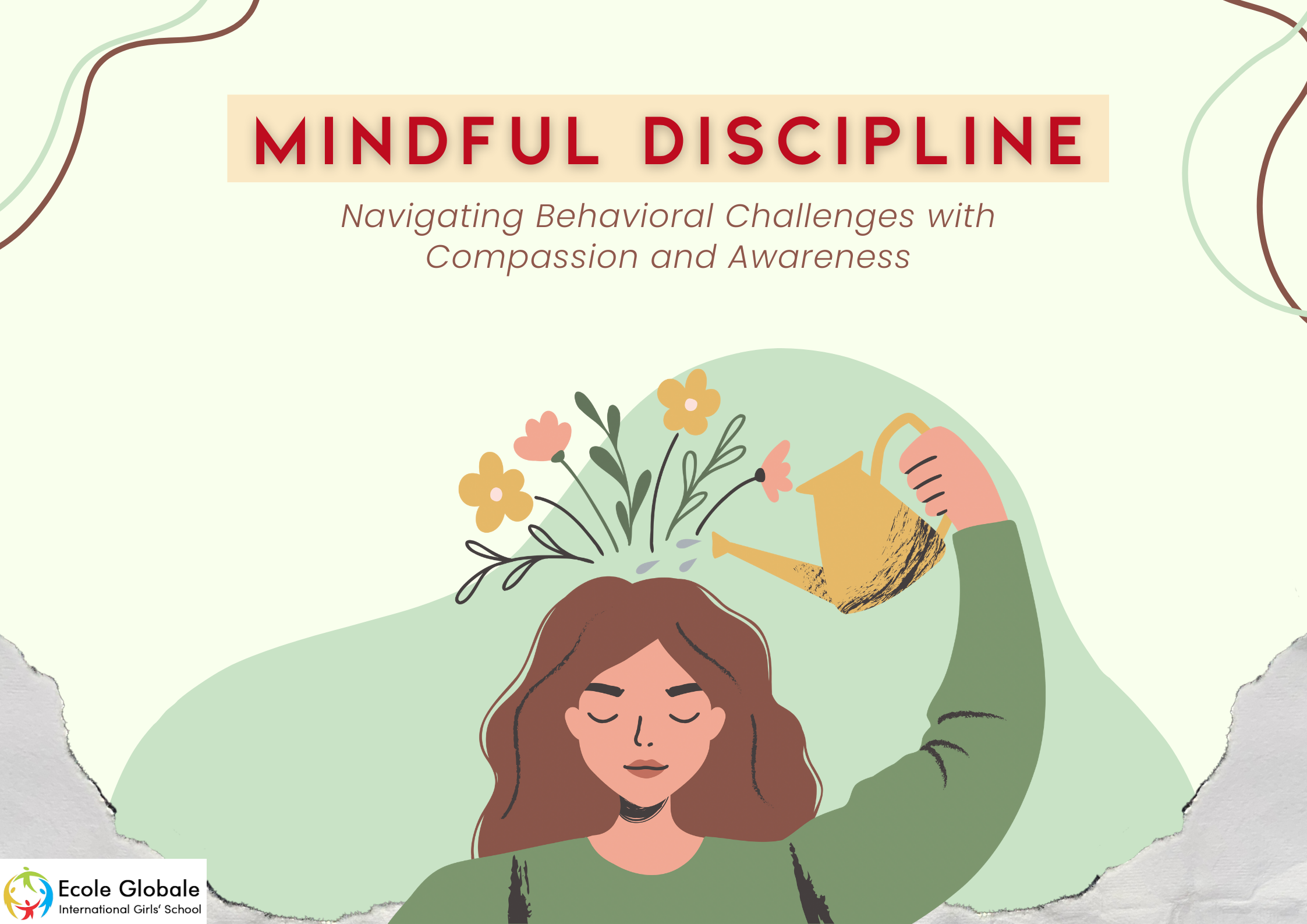Significance of Mindful Discipline

Discipline is really important for student life. In the intricate journey of parenting, disciplining children is a nuanced art that requires a delicate balance of guidance, understanding, and compassion. Mindful discipline, rooted in the principles of mindfulness, offers a holistic approach to address behavioral challenges.
This guide explores the essence of mindful discipline parenting, providing effective strategies for parents to navigate and positively influence their children’s behavior.
Understanding Behavioral Challenges in Children

Behavioral challenges are a natural part of childhood development. Children often express themselves through their actions, seeking attention, understanding, or simply testing boundaries. Recognizing the underlying causes of these challenges is the first step in implementing mindful discipline.
Overview of Mindful Parenting and Its Impact on Discipline

Mindful parenting involves cultivating awareness and being fully present in the parenting journey. It emphasizes non-judgmental acceptance of the child’s emotions and behaviors. The impact of mindful parenting on discipline extends beyond correcting actions to fostering emotional intelligence and building a strong parent-child relationship.
The Foundation of Mindful Discipline
Cultivating Mindfulness as Parents
- Mindful Breathing and Presence:
Start by incorporating mindful discipline breathing exercises into your daily routine. Pausing to breathe deeply in moments of stress allows you to respond to challenging situations with a clear and focused mind.
- Embracing Non-Judgmental Awareness:
Practice observing your child’s behavior without immediate judgment. Instead of reacting impulsively, approach situations with non-judgmental awareness, recognizing that behavior is often a reflection of underlying emotions.
Recognizing the Connection Between Emotions and Behavior
- Identifying Triggers and Emotional Responses:
Pay attention to the situations or events that trigger specific behaviors in your child. Understanding these triggers provides insights into their emotional responses, enabling you to address the root cause of challenging behaviors.
- Nurturing Emotional Intelligence in Children:
Actively nurture your child’s emotional intelligence by encouraging them to label and express their emotions. By fostering emotional literacy, you equip them with the tools to navigate and communicate their feelings more effectively.
Building a Positive Parent-Child Relationship
Establishing Open Communication
- Active Listening and Empathy:
Develop active listening skills to understand your child’s perspective. Show empathy by acknowledging their feelings, even if you may not agree with their behavior. This creates a foundation for open communication.
- Encouraging Children to Express Emotions:
Create a safe space for your child to express their emotions without fear of judgment. Encourage them to communicate their feelings verbally or through other expressive outlets like drawing or journaling.
Strengthening the Parent-Child Bond
- Quality Time and Shared Activities:
Dedicate quality time to engage in shared activities with your child. Building positive experiences together strengthens the parent-child bond, creating a foundation of trust and connection.
- Fostering a Sense of Belonging and Security:
Ensure your child feels a sense of belonging and security within the family unit. A secure attachment provides a solid base for children to explore and navigate the world, fostering emotional resilience.
Setting Clear and Consistent Expectations
Defining Household Rules and Boundaries
- Collaborative Rule-Setting Process:
Involve your child in the rule-setting process. Discuss and collaboratively establish household rules and boundaries, ensuring that they understand the reasons behind each rule.
- Communicating Expectations Effectively:
Clearly communicate your expectations to avoid misunderstandings. Use age-appropriate language to explain the reasons behind rules, emphasizing the importance of mutual respect.
Consistency in Discipline
- Fairness and Predictability:
Consistency is key in discipline. Be fair and predictable in your responses to behaviors. Children thrive in environments where they understand the consequences of their actions.
- Addressing Behavioral Issues Promptly:
Address behavioral issues promptly to reinforce the connection between actions and consequences. Timely responses contribute to a child’s understanding of cause and effect.
Redirecting Negative Behavior with Positive Reinforcement
Emphasizing Positive Reinforcement
- Acknowledging and Celebrating Positive Behavior:
Reinforce positive behavior by acknowledging and celebrating your child’s achievements and efforts. Positive reinforcement fosters a sense of accomplishment and encourages desired behaviors.
- Encouraging Intrinsic Motivation:
Shift the focus from external rewards to intrinsic motivation. Help your child find joy and satisfaction in their accomplishments, promoting a sense of internal fulfillment.
Redirecting Negative Behavior Constructively
- Offering Alternatives and Choices:
Instead of simply correcting negative behavior, offer alternatives and choices. Empower your child to make positive decisions, providing them with a sense of autonomy and responsibility.
- Teaching Problem-Solving Skills:
Encourage problem-solving by involving your child in finding solutions to challenges. This collaborative approach instills critical thinking skills and empowers them to navigate difficulties independently.
Implementing Consequences Mindfully
Understanding Natural Consequences
- Allowing Children to Experience Consequences:
When appropriate, allow children to experience the natural consequences of their actions. This provides valuable learning opportunities and encourages responsible decision-making.
- Balancing Learning Opportunities with Safety:
While natural consequences are important, ensure that the safety of your child is always prioritized. Balance learning opportunities with the need to keep them safe from harm.
Logical Consequences and Learning
- Ensuring Consistency with Actions:
Logical consequences should be directly related to the behavior in question. Ensure consistency between actions and consequences to reinforce the connection in your child’s mind.
- Explaining the Connection Between Behavior and Consequences:
Communicate the link between behavior and consequences clearly. Help your child understand the cause-and-effect relationship, fostering a sense of accountability.
The Role of Reflection and Communication
Encouraging Self-Reflection
- Teaching Children to Reflect on Their Behavior: Foster a habit of self-reflection in your child. Encourage them to think about their actions, the impact on others, and alternative choices they could have made.
- Fostering Accountability and Responsibility: Connect self-reflection to accountability and responsibility. Help your child understand that their actions have consequences, and taking responsibility is a crucial part of personal growth.
Open Communication About Behavior
- Establishing a Safe Space for Dialogue:
Create an environment where your child feels safe to discuss their behavior openly. Be approachable and non-judgmental, allowing for honest conversations about their experiences and feelings.
- Encouraging Children to Share Their Perspectives:
Actively encourage your child to share their perspectives on their behavior. This helps them develop a sense of agency and ownership over their actions, promoting self-awareness.
Mindful Discipline Strategies for Dealing with Challenging Behavior
Calming Techniques for Parents and Children
- Deep Breathing Exercises:
Incorporate deep breathing exercises into your routine, especially during moments of tension. Teach your child simple breathing techniques to help them manage stress and emotions.
- Mindful Discipline Approaches to Stressful Situations:
Practice mindfulness in stressful situations. Instead of reacting impulsively, take a moment to assess the situation mindfully, choosing a measured response over immediate reaction.
Time-Outs as a Mindful Discipline Tool
- Implementing Time-Outs Effectively:
When necessary, use time-outs as a mindful discipline tool. Ensure that time-outs are implemented effectively, providing a space for both parent and child to calm down before addressing the issue.
- Using Time-Outs for Reflection, Not Punishment:
Position time-outs as an opportunity for reflection rather than punishment. This approach helps children understand the importance of taking a moment to gather their thoughts and make better choices.
Collaborative Problem-Solving
Involving Children in Solutions
- Engaging in Collaborative Discussions:
Involve your child in discussions about finding solutions to challenges. Collaborative problem-solving empowers them to contribute to decision-making, fostering a sense of autonomy.
- Empowering Children to Propose Solutions:
Empower your child to propose solutions to issues they encounter. This process not only encourages creativity but also instills a sense of responsibility for resolving problems.
Building a Sense of Ownership
- Encouraging Responsibility for Actions:
Reinforce the concept of personal responsibility for one’s actions. Help your child understand that they have control over their behavior and that their choices impact themselves and those around them.
- Reinforcing Positive Contributions:
Acknowledge and reinforce positive contributions to problem-solving. Celebrate the efforts your child puts into finding solutions, reinforcing a positive and proactive mindset.
Balancing Discipline with Empathy
Understanding the Child’s Perspective
- Practicing Empathetic Listening:
Cultivate empathetic listening skills. When your child expresses themselves, make an effort to understand their perspective, even if you may not fully agree. This fosters a sense of being heard and understood.
- Validating Emotions Without Condoning Behavior:
Separate validating your child’s emotions from condoning negative behavior. Let them know that their feelings are valid while helping them understand that certain behaviors may be inappropriate.
Incorporating Teachable Moments
- Turning Challenges into Learning Opportunities:
View challenges as teachable moments. Instead of focusing solely on correction, emphasize the lessons that can be learned from each situation, promoting continuous growth and development.
- Modeling Mindful discipline Behavior as Parents:
Modeling mindful discipline behavior as parents. Children learn by observing, and seeing mindfulness in action sets a powerful example for them to emulate in their own lives.
Seeking Professional Support When Needed
Recognizing the Limits of Mindful Discipline
- Addressing Persistent Behavioral Challenges:
Acknowledge when persistent behavioral challenges surpass your ability to address them independently. Seeking professional support from child psychologists or counselors can provide additional insights and strategies.
- Consulting with Child Psychologists or Counselors:
If needed, consult with child psychologists or counselors who specialize in behavioral issues. Professional guidance can offer a deeper understanding of underlying factors and provide tailored interventions.
Nurturing a Mindful Home Environment
Creating a Calm and Supportive Atmosphere
- Mindful Discipline Home Practices:
Integrate mindful discipline practices into your daily routine at home. Whether through meditation, gratitude exercises, or simply fostering an atmosphere of calm, mindfulness contributes to a positive home environment.
- Modeling Mindfulness as Parents:
Be intentional about modeling mindfulness. As parents, embody the principles of mindfulness in your own actions and responses, creating a harmonious and balanced atmosphere for the entire family.
Conclusion
In conclusion, mindful discipline is a transformative approach to parenting that goes beyond correcting behavior—it nurtures emotional intelligence, strengthens parent-child bonds, and fosters a positive home environment.
By cultivating mindfulness, recognizing the connection between emotions and behavior, and building open communication, parents can navigate behavioral challenges with compassion and awareness.
Setting clear expectations, using positive reinforcement, and implementing consequences mindfully contribute to a disciplined yet nurturing parenting approach. The incorporation of mindful discipline strategies, collaborative problem-solving, and balancing discipline with empathy creates an environment where children thrive and develop lifelong skills for well-being.
Remember, mindful parenting is a continuous journey, and with each mindful interaction, parents shape not only their children’s behavior but also their character and resilience.
May these strategies guide parents in fostering a mindful discipline and loving home where discipline is a transformative and enriching experience for both parents and children alike.



















